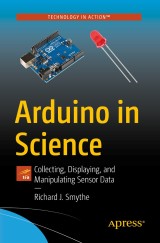Details

Arduino in Science
Collecting, Displaying, and Manipulating Sensor Data|
56,99 € |
|
| Verlag: | Apress |
| Format: | |
| Veröffentl.: | 07.10.2021 |
| ISBN/EAN: | 9781484267783 |
| Sprache: | englisch |
Dieses eBook enthält ein Wasserzeichen.
Beschreibungen
<div>It’s a simple question, but do you know how to take basic measurements with your Arduino, Raspberry Pi or PC? A lot of the times, you know how to use microcontrollers, sensors, and programming skills to collect data. This book takes it one step further to teach you how to transform your PC, Raspberry Pi, and Arduino to a device that can measure, collect, and analyze data.</div><div><br></div><div>You'll begin from a simple starting point reviewing the basics of electronics and digital and analog concepts. As you advance through this book, you’ll work through 10 exercises to develop a working knowledge of microcontroller properties and graphical data presentation concepts, basic electronic technology, and the fundamentals of controlling and acquiring data.</div><div><br></div><div><i>Arduino in Science</i> is your guide to monitoring and measuring physical – chemical parameters with integrated circuitry and physical computational systems.<br></div><div><br></div><div><b>What You’ll Learn</b></div><div><ul><li>Review fundamental human machine interfacing with supervisory control and data acquisition software<br></li><li>Examine timing, counting, and serial communication concepts</li><li>Adapt microcontrollers to perform sophisticated functions<br></li><li>Understand collection and presentation of data</li></ul></div><div><b>Who This Book Is For</b><br></div><div><br></div><div>Beginner-level students, citizen scientists, and hobbyists, and is also great for educators who can seamlessly implement this content into STEM programs.</div>
<p>Chapter 1: Button Control of LED Illumination.- Chapter 2: Power Control Monitoring and Creation of Dedicated Graphical User Interfaces.- Chapter 3: Introduction to Scripting.- Chapter 4: Data Entry from the Screen.- Chapter 5: Digital Signal Concepts and Digital Signal Outputs.- Chapter 6: Analog or Digital Conversions for Input and Output.- Chapter 7: Variable Intensity and Power Controls.- Chapter 8: Counting Events and Timing.- Chapter 9: Graphical Data Recording .- Chapter 10: Current Control.- Chapter 11: Microcontrollers and Serial Communications.-</p>
<div>Richard J. Smythe attended Brock University in its initial years of operation in southern Ontario and graduated with a four year honours degree in chemistry with minors in mathematics and physics prior to attending the University of Waterloo for a master’s degree in analytical chemistry and computing science and a doctorate in analytical chemistry. After a post-doctoral fellowship at the State University of New York at Buffalo in electro-analytical chemistry Richard went into business in 1974 as Peninsula Chemical Analysis Ltd. Introduced in 1966 to time-shared computing with paper tapes, punched cards, BASIC prior to Fortran IV at Waterloo, the PDP 11 mini-computers and finally the PC, Richard has maintained a currency in physical computing using several computer languages and scripting codes. Professionally Richard has functioned as a commercial laboratory owner and is currently a consulting analytical chemist, a civil forensic scientist as PCA Ltd., a full partner inWalters Forensic Engineering in Toronto, Ontario and senior scientist for Contrast Engineering in Halifax Nova Scotia. A large portion of Richard's professional career consists of devising methods by which a problem that ultimately involves making one or more fundamental measurements can be solved by using the equipment at hand or using a readily available “off-the shelf/ out of the box” facility to provide the data required.</div>
It’s a simple question, but do you know how to take basic measurements with your Arduino, Raspberry Pi or PC? A lot of the times, you know how to use microcontrollers, sensors, and programming skills to collect data. This book takes it one step further to teach you how to transform your PC, Raspberry Pi, and Arduino to a device that can measure, collect, and analyze data.<div><br></div><div>You'll begin from a simple starting point reviewing the basics of electronics and digital and analog concepts. As you advance through this book, you’ll work through 10 exercises to develop a working knowledge of microcontroller properties and graphical data presentation concepts, basic electronic technology, and the fundamentals of controlling and acquiring data.</div><div><br></div><div><i>Arduino in Science</i> is your guide to monitoring and measuring physical – chemical parameters with integrated circuitry and physical computational systems.<br></div><div><br></div><div>You will:</div><div><ul><li>Review fundamental human machine interfacing with supervisory control and data acquisition software<br></li><li>Examine timing, counting, and serial communication concepts</li><li>Adapt microcontrollers to perform sophisticated functions<br></li><li>Understand collection and presentation of data</li></ul></div>
Learn the process of implementing supervisory control and data acquisition software – human machine interface concepts to the management of sensor or experimental set-up based measurements Develop and assemble your own computer controlled measurement systems and real-time graphical data displays Quickly and simply learn how to interface any simple basic experimental measurement set-up to a computer
Diese Produkte könnten Sie auch interessieren:

Virtual Organizations
von: Luis M. Camarinha-Matos, Hamideh Afsarmanesh, Martin Ollus
Preis: 149,79 €

Quantitative Measure for Discrete Event Supervisory Control
von: Asok Ray, Vir V. Phoha, Shashi Phoha
Preis: 96,29 €
-
-
© 2024 media control GmbH
Alle Preise enthalten die gesetzliche Mehrwertsteuer. - AGB
- Impressum
- Datenschutzerklärung
- Kontakt
- FAQ
- Mein Konto
- Home
- Erweiterte Suche
- Widerrufsrecht
- Reader-Software
- Desktop-Ansicht
- Gutschein-Code einlösen
